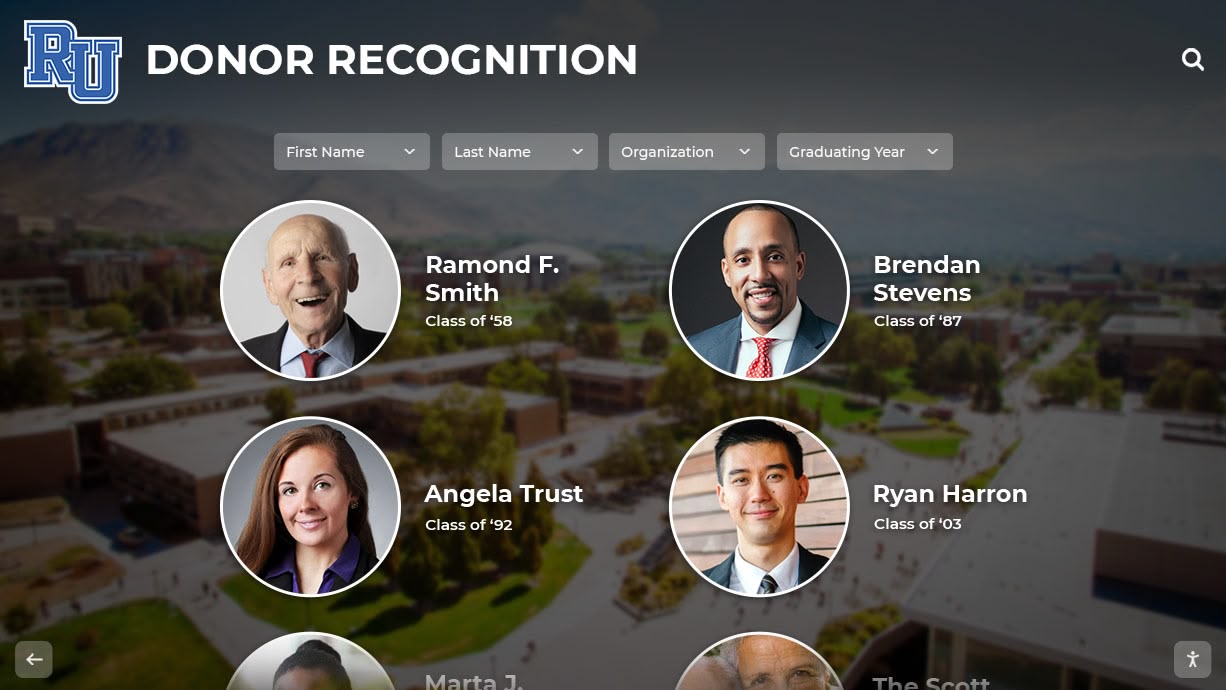Key Takeaways
Discover how interactive sorority history walls transform Greek life recognition. Explore digital displays, composite preservation, and engaging sisterhood celebration technology for modern sororities.
Digital sorority history walls address the fundamental limitations of traditional recognition while enhancing what sororities value most—sisterhood celebration, historical preservation, alumnae connection, and pride in chapter identity. These modern systems enable chapters to showcase unlimited members without wall space constraints, tell complete stories through photos, videos, and detailed profiles, maintain living histories that grow and evolve with each member class, provide global access for geographically dispersed alumnae networks, and create engaging experiences that inspire current and prospective members.
Whether your sorority seeks to revitalize outdated physical displays, preserve deteriorating historical materials, strengthen alumnae engagement, or create comprehensive recognition systems that honor every sister’s contribution, understanding the possibilities and best practices of interactive history walls transforms how Greek organizations celebrate and connect with their communities.
Understanding Interactive Sorority History Walls
Interactive sorority history walls merge time-honored Greek life traditions with contemporary digital capabilities, creating recognition systems that honor the past while embracing technological possibilities that enhance engagement and accessibility.
The Evolution of Sorority Recognition and Composites
Traditional sorority recognition has followed consistent patterns for generations—framed composite photographs displaying each member class arranged chronologically along chapter house hallways, trophy cases showcasing awards and achievements, and scrapbooks documenting events, philanthropies, and milestones. These physical displays served important purposes, creating tangible connections to chapter history and visual celebrations of sisterhood.
Yet traditional approaches carry inherent limitations that modern sororities increasingly find problematic. Wall space constraints force difficult decisions when adding new composites, often resulting in oldest or least prominent displays being relegated to storage or secondary locations. Physical composites deteriorate over time, with photographs fading, frames aging, and glass breaking, requiring expensive restoration or replacement. Limited information capacity means composites show faces and names but rarely capture the stories, achievements, or personalities behind the portraits.
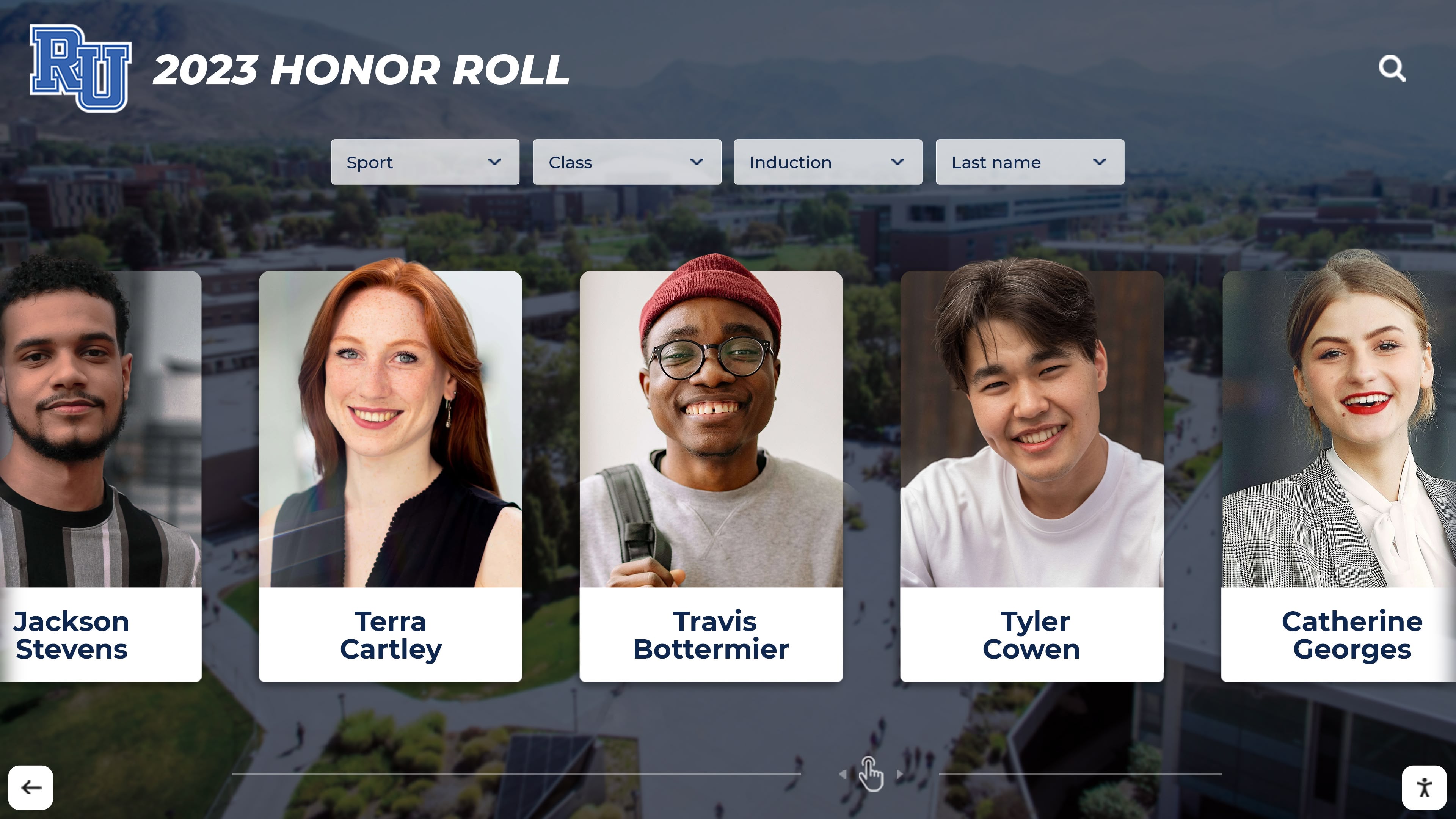
Static, Unchanging Presentation: Once hung, physical composites remain frozen in time. Members who achieve significant milestones after graduation see no updates reflecting career accomplishments, philanthropic leadership, or continued contributions to sorority values. This static nature fails to demonstrate the lifelong impact of Greek life experiences.
Minimal Engagement and Accessibility: Physical displays accommodate only those present at chapter houses. Alumnae living across the country or world have limited opportunities to revisit their composite years, explore subsequent member classes, or maintain visual connections to chapter history. Prospective members during recruitment see limited historical context beyond what physical space allows.
What Makes Sorority History Walls “Interactive”
Interactive digital history walls overcome these traditional limitations through sophisticated technology specifically designed for Greek life recognition. Touchscreen interfaces enable visitors to actively explore chapter history rather than passively viewing fixed displays, creating engaging experiences that reveal deeper connections to sisterhood and tradition.
Unlimited Recognition Capacity: Digital platforms accommodate every member from chapter founding through present day without physical space constraints. Sororities can honor complete historical membership rather than making difficult selection decisions based on available wall space. This comprehensive approach ensures inclusive recognition celebrating every sister regardless of initiation year.
Rich Multimedia Storytelling: Beyond composite photos, digital history walls incorporate individual member profiles with biographical information and achievements, video messages from distinguished alumnae, historical photographs documenting chapter events and traditions, scanned archival materials including founding documents and significant correspondence, and interactive timelines showing chapter evolution across decades or centuries.
Dynamic, Living History: As members achieve milestones throughout their lives, digital profiles can be updated instantly reflecting current accomplishments. This evolving recognition demonstrates ongoing chapter pride in member success rather than acknowledgment frozen at graduation. Solutions like Rocket Alumni Solutions provide cloud-based platforms enabling easy updates from anywhere.
Global Accessibility: Web-enabled components extend recognition beyond physical chapter houses. Alumnae living anywhere worldwide can explore their initiation class, browse subsequent member generations, and maintain connections to chapter history despite geographic distance. This accessibility proves particularly valuable for chapters with nationally or internationally distributed alumnae networks.
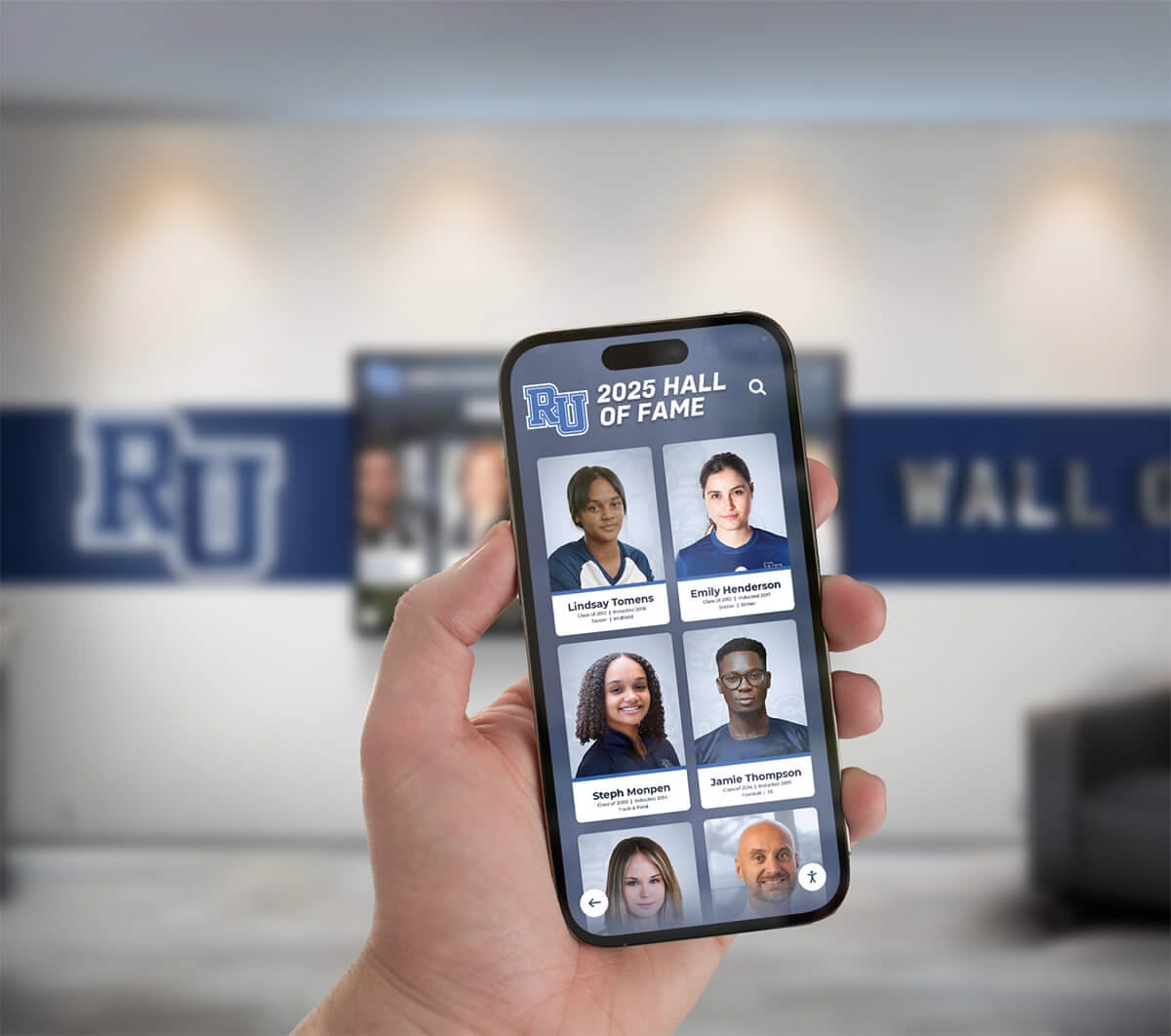
Benefits of Interactive Sorority History Walls
Modern sorority history walls deliver measurable advantages across multiple dimensions of Greek life, from member recruitment and engagement through alumnae relations and historical preservation.
Enhanced Member Recruitment and Engagement
Recruitment represents the most critical process for chapter sustainability, and interactive history walls create powerful impression during potential new member visits. Sophisticated digital displays communicate organizational investment in heritage and sisterhood, demonstrate technological relevance matching prospective members’ expectations, provide compelling visual experiences that differentiate chapters during competitive recruitment, and create shareable content that extends recruitment impact through social media.
Prospective members exploring interactive displays discover concrete examples of chapter values in action—philanthropic initiatives demonstrating service commitment, academic achievements showcasing scholarship priorities, leadership positions illustrating development opportunities, and sisterhood traditions revealing the unique culture they’re considering joining. This tangible evidence proves more persuasive than abstract values statements.
Current Member Pride and Identity: Active members benefit from strengthened connections to chapter identity and sisterhood tradition. When members can explore their chapter’s founding story, discover distinguished alumnae who walked the same halls, and see their own initiation class celebrated within comprehensive chapter history, they develop deeper appreciation for their place within continuing legacies.
Interactive elements encourage voluntary exploration rather than passive viewing. Members discovering that distinguished professionals in fields matching their interests are chapter alumnae gain inspiration and potential mentorship connections. Seeing how current traditions evolved across decades creates context that strengthens attachment to rituals and practices.
Strengthened Alumnae Engagement and Connection
Alumnae represent vital resources for sororities—offering mentorship, professional networks, financial support, and institutional memory that sustains chapters across generations. Yet maintaining strong alumnae engagement proves challenging when graduates live dispersed across the country or world with limited opportunities to visit chapter houses physically.
Interactive history walls with remote web access solve this accessibility challenge. Alumnae living anywhere can explore their initiation class, reminisce about specific events they experienced, discover what happened at their chapter after graduation, and share discoveries with family members and former sisters. This convenient access keeps alumnae emotionally connected regardless of geographic distance from chapter houses.
Research on digital alumni recognition systems demonstrates that visible acknowledgment significantly increases engagement and philanthropic support. When sorority alumnae see their membership honored through professional, accessible recognition displays, they maintain warmer feelings toward chapters that translate into increased volunteer participation, event attendance, and financial contributions.
Reunion and Event Enhancement: Digital history displays create natural gathering points during alumnae reunions and homecoming events, sparking conversations as sisters discover forgotten moments, compare memories about specific events or traditions, explore what changed at their chapter since graduation, and introduce family members to their sorority history. These informal interactions around historical displays strengthen sisterhood bonds while creating memorable reunion experiences.
Historical Preservation and Institutional Memory
Beyond celebrating current members, interactive history walls preserve chapter legacies for future generations. Without systematic preservation efforts, historical knowledge held by graduating members or aging alumnae risks disappearing permanently. Digital documentation creates lasting records ensuring chapter memories remain available decades or centuries from now.
Sororities often possess valuable historical materials—founding documents, early composite photographs, correspondence from significant chapter events, scrapbooks documenting decades of activities, and physical memorabilia representing important milestones. These materials face deterioration risks from aging, environmental exposure, or inadequate storage. Digitization projects that scan and preserve these items in digital formats safeguard against permanent loss while making content accessible to broader audiences.
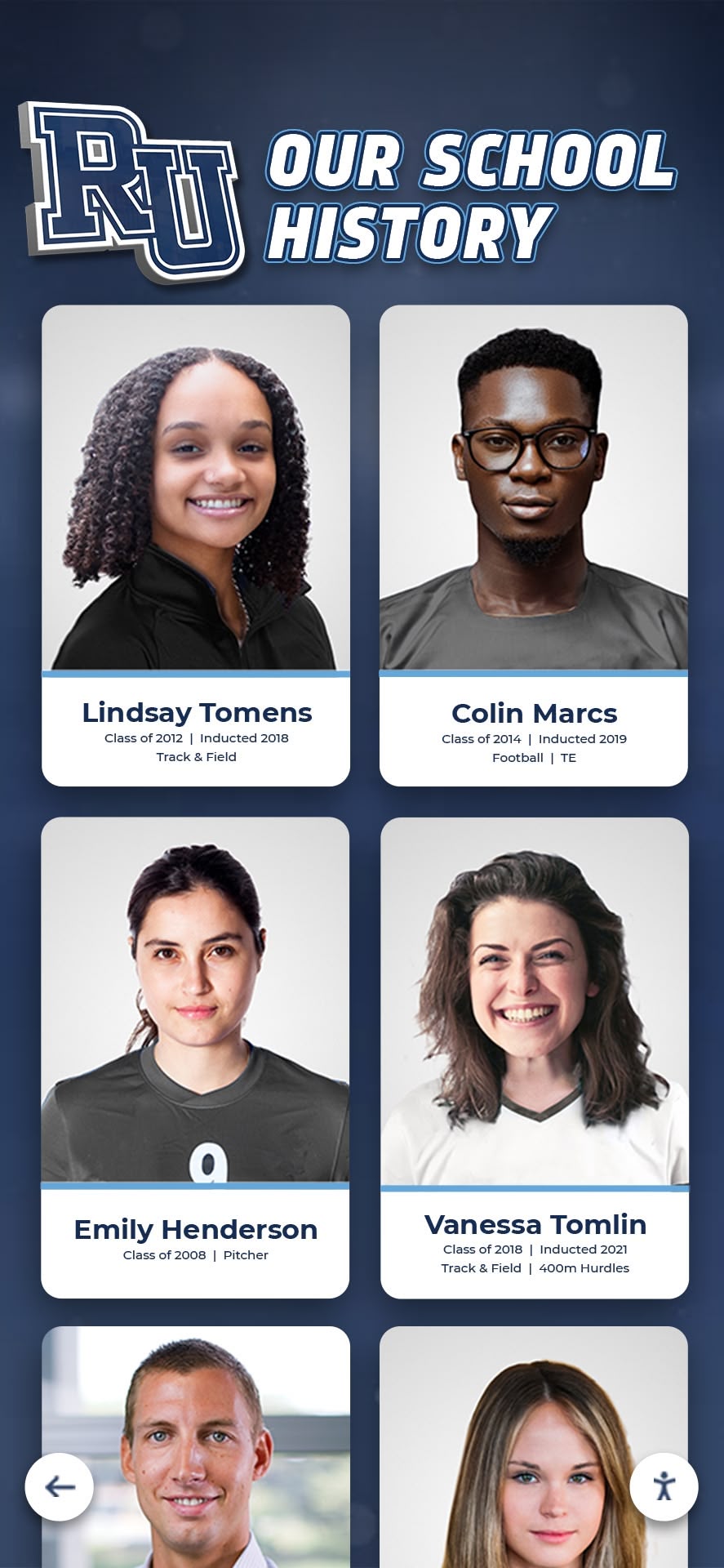
Multi-Generational Sisterhood: Interactive history walls help current members understand their connections to alumnae they’ve never met. Discovering that their big sister’s big sister’s big sister was a chapter president in 1985, or seeing how their favorite tradition started with a small group of members decades ago, creates tangible links across generations that abstract “sisterhood” concepts cannot match.
Supporting Chapter Operations and Development
Greek life advisors and sorority nationals increasingly emphasize data-driven chapter management, continuous improvement, and strategic planning. Interactive history walls with analytics capabilities provide valuable insights into member engagement, alumnae interaction patterns, and content that resonates most effectively with diverse audiences.
Understanding which historical periods generate most interest, which member profiles receive most views, or which chapter milestones alumnae explore most frequently informs strategic decisions about anniversary celebrations, fundraising themes, or recruitment messaging. This data proves impossible to gather from traditional physical displays.
Additionally, comprehensive digital history serves important continuity functions during leadership transitions. New officers can explore how predecessors handled similar challenges, understand how chapter traditions evolved, and maintain institutional memory that might otherwise be lost when members graduate.
Planning Your Interactive Sorority History Wall
Successful interactive history wall implementations begin with thoughtful planning addressing chapter needs, member preferences, budget constraints, and long-term sustainability.
Defining Recognition Goals and Priorities
Before evaluating technologies or developing content, establish clear objectives guiding all subsequent decisions and enabling assessment of implementation success.
Common Sorority History Wall Objectives:
- Replace aging physical composites freeing chapter house wall space
- Increase member awareness of and pride in chapter history
- Strengthen alumnae connections through accessible heritage content
- Enhance recruitment experiences for potential new members
- Preserve deteriorating historical materials through digitization
- Create social media-worthy experiences generating organic promotion
- Demonstrate chapter heritage during Greek life awards or university reviews
- Provide mentorship connections between members and accomplished alumnae
Stakeholder Input: Engage diverse perspectives when defining goals—current undergraduate members who’ll interact with displays daily, alumnae who’ll access content remotely, chapter advisors focused on strategic objectives, and house corporation representatives concerned with physical installations. Inclusive planning ensures recognition systems serve all constituencies rather than favoring single groups.
Content Scope and Organization Strategy
Digital history walls can encompass complete chapter histories or focus on specific recognition aspects. Clarifying scope early prevents common pitfalls of attempting overly ambitious projects that never reach completion.
Comprehensive Historical Coverage: Complete chapter timelines document founding and establishment details, charter member identification, leadership succession through all member classes, significant chapter awards and Greek life recognitions, philanthropy evolution and community service milestones, facility history including house purchases and renovations, tradition development and ceremonial evolution, and relationships with sorority nationals and university Greek life offices.
This exhaustive approach creates authoritative historical resources serving diverse purposes—recruitment conversations, anniversary celebrations, university presentations, and alumnae nostalgia—simultaneously.
Focused Recognition Approaches: Alternatively, sororities might initially concentrate on specific dimensions such as digital composite galleries showcasing every member class, distinguished alumnae profiles highlighting career achievements, philanthropy documentation celebrating service impact, or leadership recognition honoring chapter officers across all years.
Focused implementations allow faster launch with achievable initial scope, with systematic expansion adding additional content categories as resources permit and value demonstrates.
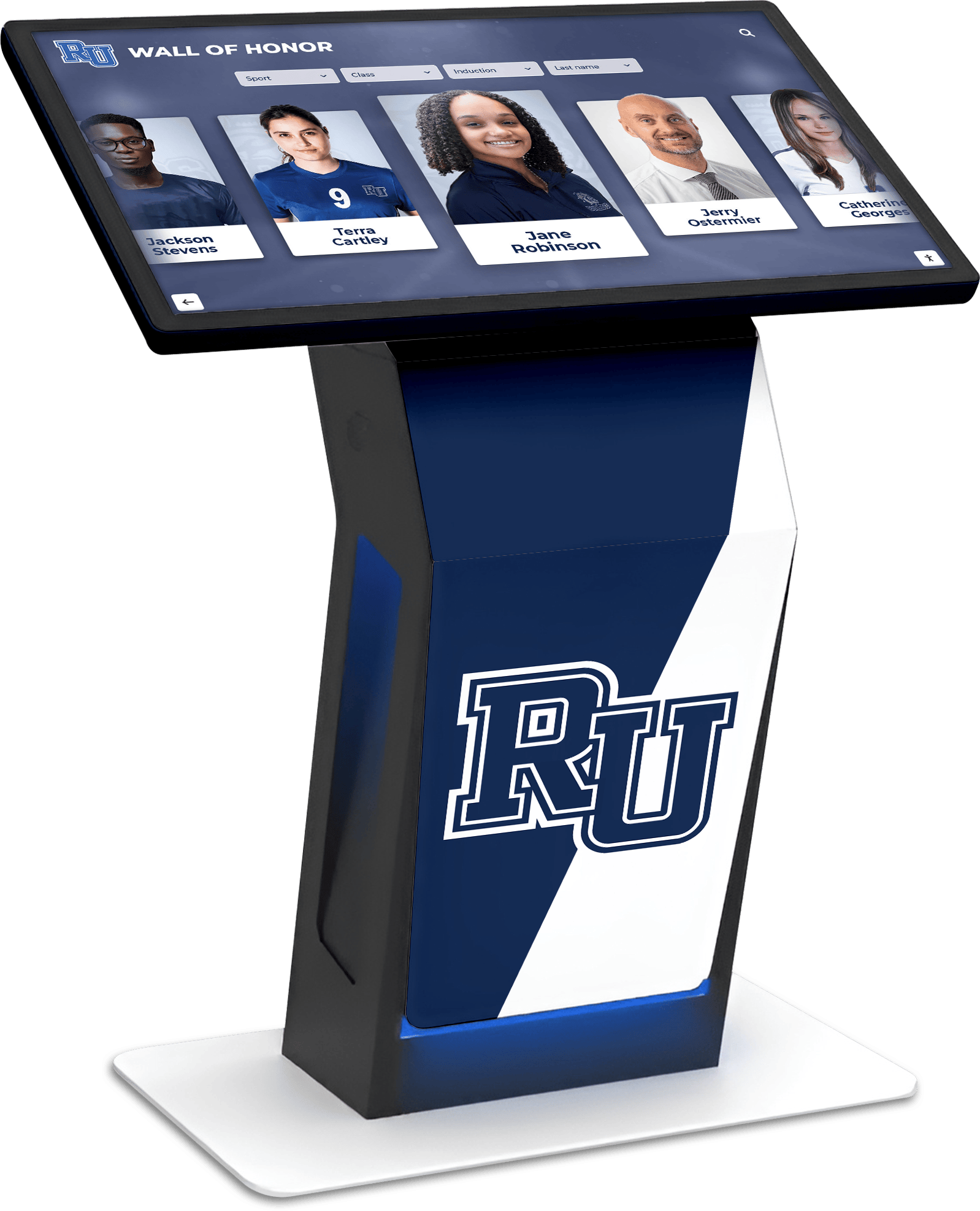
Organizational Frameworks: Digital platforms support multiple organizational structures accommodating different exploration preferences. Chronological organization presenting history in date order works well for comprehensive institutional overviews. Member class organization groups all members by initiation year, replicating familiar composite structure while adding interactive depth. Thematic organization might group content by philanthropy initiatives, leadership positions, academic achievements, or social traditions. Hybrid approaches combine elements, perhaps organizing primarily chronologically while allowing thematic filtering within the chronological structure.
Budget Planning and Resource Allocation
Interactive history wall investments include initial hardware and software acquisition, professional installation, content development, and ongoing operational costs. Comprehensive budgeting prevents common underestimation that derails projects or creates unsustainable systems.
Initial Implementation Investment:
- Touchscreen display hardware: $3,000-$8,000 depending on size and quality
- Content management software licensing: $2,000-$5,000 for purpose-built platforms
- Professional installation: $800-$2,000 for mounting, connectivity, and configuration
- Historical content digitization: $1,000-$5,000 depending on material volume
- Initial content development: $1,000-$4,000 for profile creation and organization
- Training for chapter members: $500-$1,000 for content management instruction
Most comprehensive sorority history wall implementations range $8,000-$25,000 for complete initial deployment. Larger chapters with extensive historical archives or multi-display installations may invest more, while smaller chapters can implement effective systems in the lower range.
Ongoing Annual Costs:
- Software licensing or subscriptions: $1,000-$3,000 annually
- Content updates and additions: $500-$2,000 annually for routine updates
- Technical support and maintenance: $300-$1,000 annually
- Hardware refresh planning: Budget reserves for eventual display replacement in 5-7 years
Importantly, digital systems eliminate the recurring per-member costs of printing, framing, and hanging physical composites. Chapters that historically spent $400-$800 annually on composite production find digital systems financially advantageous within 2-3 years while delivering dramatically enhanced capabilities.
Funding Strategies: Many sororities successfully fund history wall projects through special alumnae fundraising campaigns emphasizing heritage preservation, anniversary or milestone celebration budgets, alumnae class gift opportunities, house corporation capital improvement allocations, or general chapter budgets recognizing strategic engagement value.
Creating Compelling Historical Content
Technology enables impressive interactive capabilities, but compelling content quality determines whether history walls achieve their potential for engagement, inspiration, and sisterhood celebration.
Digitizing Composites and Historical Materials
Most sororities possess decades of physical composites and historical materials that form the foundation for digital history walls. Systematic digitization preserves these materials while making them accessible through modern platforms.
Composite Scanning Best Practices: Professional scanning services can efficiently process large composite photograph collections, though chapters may handle digitization internally with appropriate equipment and standards. For quality results, scan photographs at minimum 300 DPI resolution for clear digital viewing and 600 DPI for archival preservation, use non-proprietary formats like JPEG or TIFF ensuring long-term accessibility, organize files systematically with consistent naming conventions including years and member names, and back up digital collections in multiple locations protecting against data loss.
Individual Member Photo Extraction: After scanning complete composites, extract individual member portraits for searchable database inclusion. This extraction enables powerful features like name-based search, individual member profiles linking portraits to biographical information, comparison features showing individual members across different years if they appear in multiple composites, and flexible display layouts beyond traditional composite arrangements.
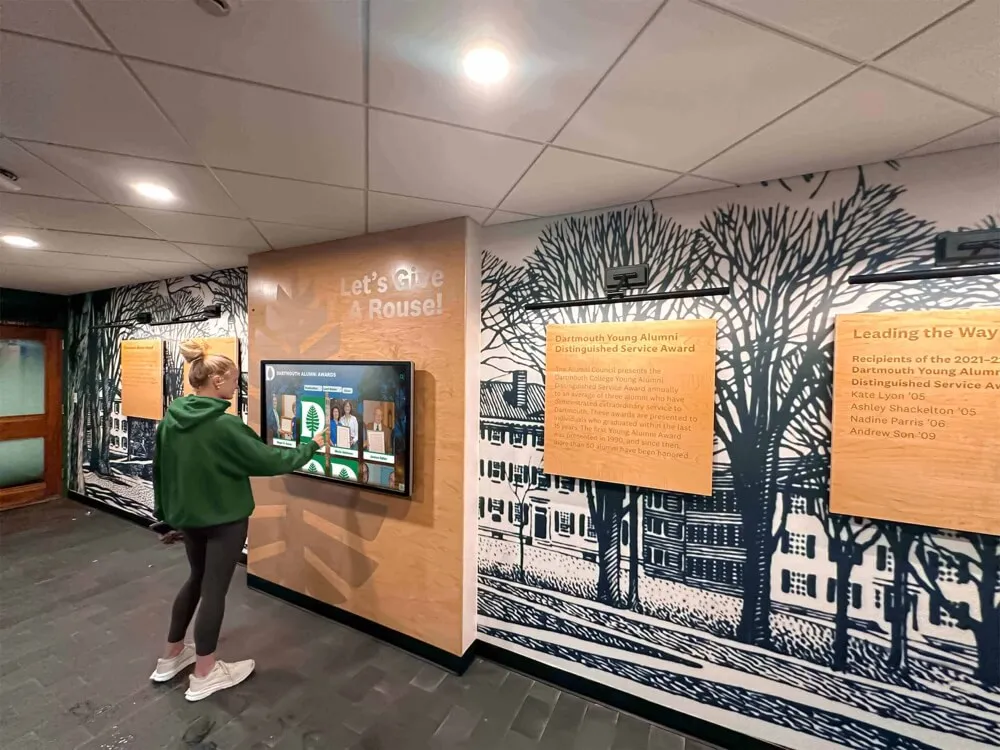
Archival Material Preservation: Beyond composites, many chapters possess valuable historical documents, photographs, scrapbooks, correspondence, and memorabilia worth digitizing. Founding chapter documents and charter information, historical event photographs from formals, philanthropies, and traditions, leadership records and officer succession documentation, awards and recognition certificates, historical correspondence and significant letters, and physical memorabilia that can be photographed from multiple angles all add depth to digital history presentations.
Solutions focused on digitizing yearbooks and archival materials provide detailed frameworks applicable to sorority historical preservation projects.
Developing Rich Member Profiles
Comprehensive member profiles transform simple name-and-face composites into engaging narratives that celebrate individual sisters while illustrating broader chapter values and impact.
Essential Profile Components:
- Professional photographs showing members at various life stages
- Basic biographical information including hometown, major, graduation year
- Chapter involvement including positions held, committees served, special contributions
- Academic achievements and honors received during college
- Post-graduation accomplishments in career, service, or personal domains
- Personal reflections about meaningful sorority experiences
- Current contact preferences for mentorship or networking connections
Gathering Member Information: Collecting comprehensive information for potentially hundreds or thousands of members requires efficient, scalable approaches. Request current members provide biographical information and photos through structured questionnaires, engage alumnae through email campaigns soliciting self-submitted profile updates, partner with alumnae association volunteers who may have personal knowledge about fellow members, mine chapter records and archives for historical information about earlier members, and conduct targeted outreach to distinguished alumnae for featured profile development.
Balancing Depth and Scale: Creating exceptionally detailed profiles for every chapter member may prove impractical for chapters with extensive membership histories. Consider tiered approaches—comprehensive featured profiles for distinguished alumnae and current chapter leaders, standard profiles with essential information for all initiated members, and streamlined entries for historical members where limited information exists.
This progressive approach allows launching with complete membership coverage while continuously enriching profiles as resources permit and information becomes available.
Documenting Chapter Traditions and Milestones
Beyond individual member recognition, compelling history walls celebrate collective experiences, traditions, and milestones that define chapter identity across generations.
Tradition Documentation: Greek life rituals and traditions create powerful bonding experiences and cultural continuity. Document these traditions comprehensively including founding and evolution stories explaining how traditions started, symbolic meanings and values traditions represent, visual documentation through photos and videos from various eras, personal reflections from members across generations sharing their tradition experiences, and connections to sorority values demonstrating how traditions reinforce organizational principles.
Milestone Celebration: Significant chapter achievements warrant featured recognition including founding anniversaries and charter establishment, significant philanthropy milestones like fundraising totals or volunteer hours, Greek life awards and university recognitions, facility acquisitions or major renovations, membership growth milestones, and relationships with distinguished alumnae who’ve maintained special chapter connections.
Philanthropy and Service Recognition: Most sororities emphasize philanthropy as central to their mission. Comprehensive service documentation might include preferred philanthropies and their organizational significance, annual service initiatives and their community impact, volunteer hours contributed across member classes, fundraising totals for various causes, partnerships with community organizations, and individual member service leadership stories.
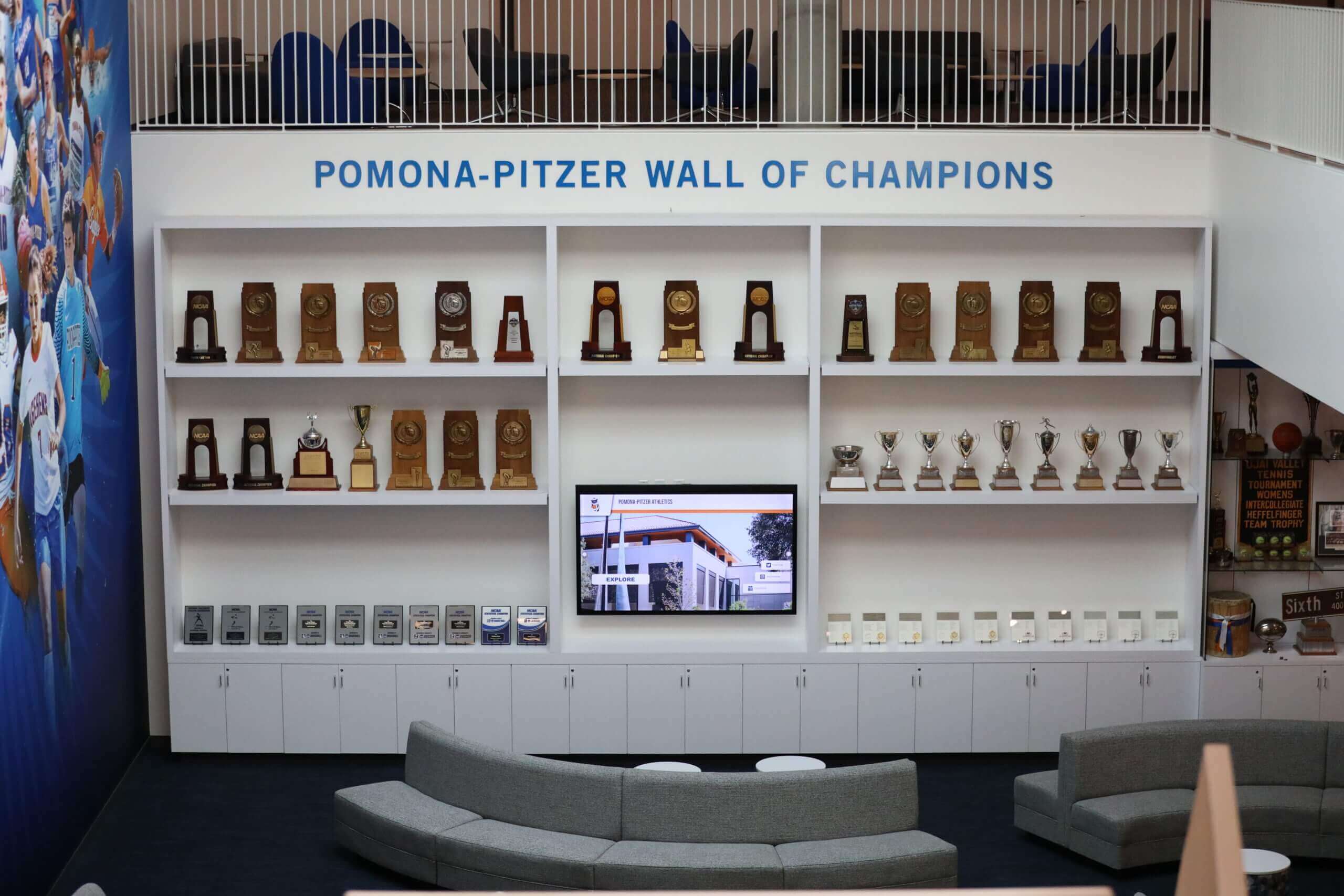
Resources on digital school history timelines provide applicable frameworks for organizing chronological institutional narratives that translate effectively to sorority contexts.
Technology Selection and Implementation
Choosing appropriate technology platforms significantly impacts user experience, administrative workload, and long-term satisfaction with interactive history wall investments.
Hardware Options for Physical Displays
Physical display installations in chapter houses provide high-visibility recognition for current members, visiting alumnae, and potential new members during recruitment.
Commercial-Grade Touchscreen Displays: Purpose-built touchscreen systems designed for continuous institutional use provide reliability and longevity that consumer televisions lack. Key specifications include screen sizes of 43-65 inches depending on viewing distances and installation locations, resolution of at least 1920x1080 (Full HD) with 4K preferred for larger displays, capacitive touch technology providing responsive smartphone-like interaction, commercial ratings indicating continuous operation capability, and anti-glare coatings maintaining visibility in varied chapter house lighting conditions.
Installation Configurations: Multiple mounting options accommodate diverse chapter house spaces and architectural constraints. Wall-mounted displays offer sleek, space-efficient installations in formal living areas, hallways, or dedicated heritage rooms. Freestanding kiosks provide self-contained units that don’t require wall mounting, offering flexibility for chapter houses where wall mounting isn’t feasible or desirable. Custom architectural integration creates seamless incorporation into existing design elements or renovated spaces.
Professional installation ensures proper mounting, cable management, network connectivity, and aesthetic integration that DIY approaches rarely achieve. Solutions like Rocket Alumni Solutions’ touchscreen systems include comprehensive installation services designed specifically for institutional environments including Greek houses.
Strategic Placement: Location dramatically influences engagement levels. High-traffic areas ensure maximum visibility—formal living rooms where members gather socially, entrance lobbies where visitors first encounter chapter spaces, dining rooms where members spend extended time, chapter meeting rooms where formal gatherings occur, or dedicated heritage rooms if chapter houses include such spaces.
Software Platforms and Content Management
Content management software determines how easily chapter members can update history walls, how intuitively visitors can navigate content, and what capabilities displays provide for engagement and analytics.
Purpose-Built vs. Generic Solutions: Recognition-specific platforms designed for alumni and member history offer purpose-designed features including profile templates optimized for member recognition, search and filtering tailored to Greek life organizational structures, content management designed for non-technical undergraduate administrators, composite display layouts replicating traditional formats while adding interactive capabilities, and integration with Greek life databases and university systems when applicable.
Generic content management systems or website builders require extensive customization achieving similar functionality. While potentially less expensive initially, customization costs, ongoing technical maintenance requirements, and feature limitations often result in higher total cost of ownership and inferior user experiences compared to purpose-built solutions.
Essential Platform Capabilities:
- Intuitive web-based content management accessible from any internet-connected device
- No-code profile creation and updates without HTML or programming knowledge
- Bulk import capabilities for efficiently migrating large historical member datasets
- Media management for photos, videos, documents, and historical materials
- Search functionality enabling visitors to find specific members quickly
- Filtering options allowing browsing by year, achievement type, or other attributes
- Social sharing features enabling easy sharing to Facebook, Instagram, LinkedIn
- Analytics tracking showing engagement patterns and popular content
Cloud-Based vs. On-Premises: Cloud-based platforms eliminate chapter IT infrastructure requirements, with providers handling server hosting, security patches, software updates, and technical maintenance remotely. This approach particularly benefits sororities with limited technical expertise or those seeking to minimize administrative burden on undergraduate chapter members.
On-premises solutions require institutional servers, ongoing technical support, and security management. While offering complete data control, self-hosted systems demand technical resources most sorority chapters lack or prefer not to dedicate to recognition systems.
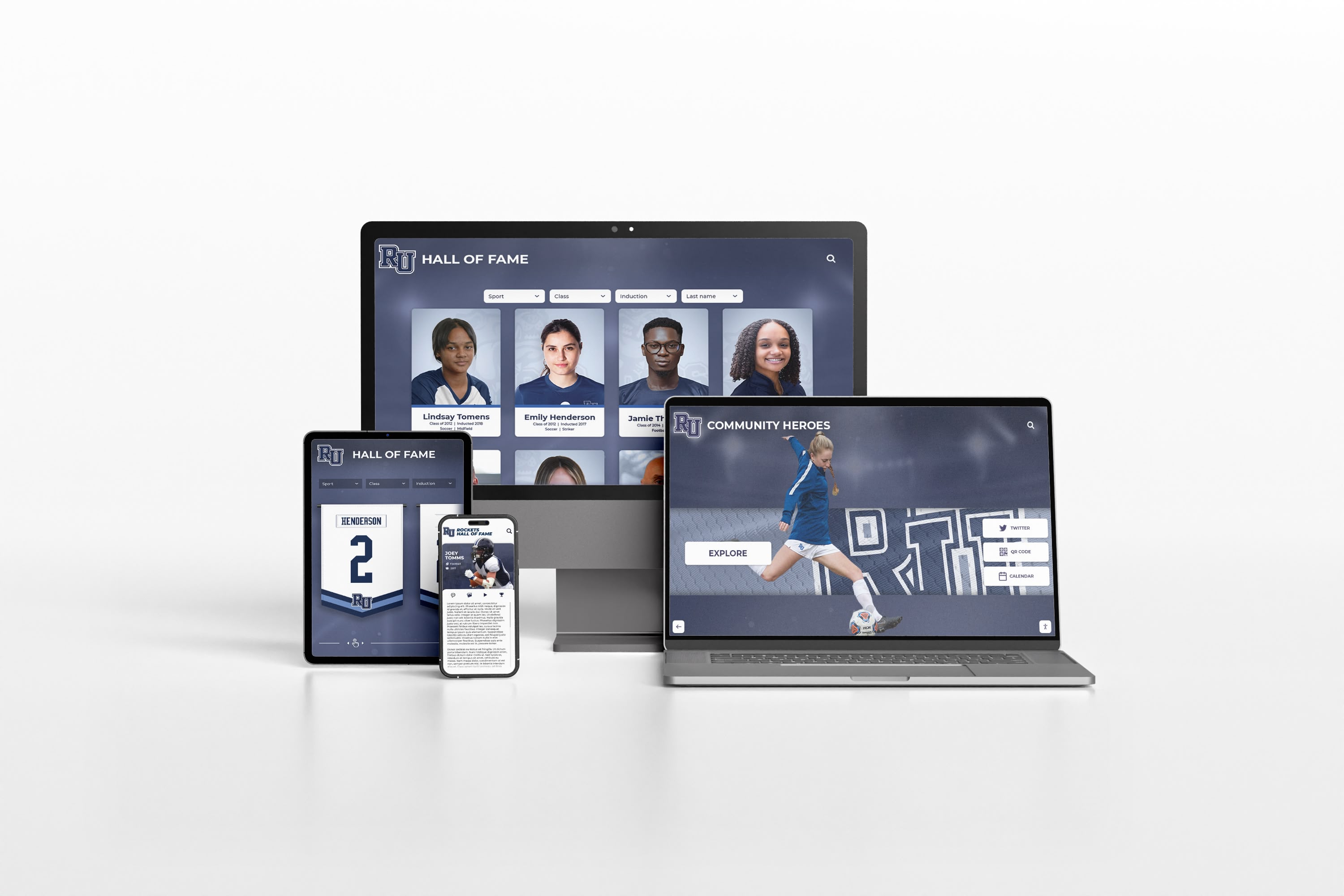
Web and Mobile Platform Extensions
Physical chapter house displays reach members and visitors present in Greek housing, but web and mobile extensions dramatically expand recognition reach to alumnae living anywhere globally and prospective members exploring sororities remotely.
Responsive Web Platforms: Companion websites provide 24/7 access to chapter history from any internet-connected device. Web platforms should deliver full functionality including search, filtering, member browsing, and multimedia viewing without requiring software downloads or special plugins.
Responsive design automatically adapts layout, navigation, and content presentation based on screen size and device capabilities. The same content seamlessly adjusts whether viewed on desktop computers, tablets, or smartphones.
Mobile Optimization Priority: Many alumnae primarily access digital content through smartphones. Mobile optimization isn’t optional—it’s essential for reaching alumnae where they naturally engage with digital media. Touch-friendly interfaces with appropriately sized buttons accommodate thumb-based mobile interaction, fast loading times respect mobile data constraints, and vertical scrolling patterns match mobile browsing behaviors.
Social Media Integration: Enable one-click sharing of member profiles, historical photos, and chapter milestones to social platforms. When members and alumnae share recognition content with personal networks, chapter visibility expands exponentially beyond official followers, reaching potential new members, parents, and university communities.
Shareable links should include preview images and descriptive text that display attractively in social feeds, encouraging clicks from connections who might not otherwise explore sorority content.
Measuring Success and Demonstrating Value
Effective recognition programs demonstrate impact through quantifiable metrics and qualitative feedback, justifying initial investment and informing continuous improvement.
Key Performance Indicators
Engagement Metrics:
- Interaction volume: Total touches, sessions, and unique users over time periods
- Session duration: Average time spent exploring historical content per visit
- Content depth: Number of profiles or pages viewed per session
- Return visitors: Percentage returning after initial visits showing sustained interest
- Search activity: Popular search terms revealing visitor interests
- Social sharing: Frequency of content shared to social media platforms
Member and Alumnae Impact:
- Recruitment effectiveness: Prospective member feedback mentioning history displays
- Member satisfaction: Current member survey responses about chapter pride and identity
- Alumnae engagement: Changes in alumnae event attendance and chapter interaction
- Giving participation: Shifts in alumnae donation rates following recognition program launch
- Mentorship connections: Alumni-student relationships formed through platform discovery
- Database growth: Profile completion rates and self-submitted information updates
Operational Efficiency:
- Recognition capacity: Number of members honored compared to traditional display limits
- Update frequency: How regularly new members are added and profiles are refreshed
- Administrative time: Chapter officer hours required for content management
- Cost per member: Total program costs divided by number of members recognized
- Maintenance needs: Technical support requirements and system reliability
Continuous Improvement Through Data
Regular analysis of engagement data reveals opportunities for content enhancement, navigation optimization, and strategic refinement.
Content Performance Review: Identify most-viewed profiles to understand what resonates. Common patterns—compelling video content, detailed career narratives, or members in specific fields—inform future development priorities. Analyze underperforming content to understand engagement gaps warranting enhancement.
User Experience Optimization: Study search patterns to identify discoverability issues. If visitors repeatedly search specific terms without successful matches, content gaps or organization deficiencies may require attention. Monitor navigation paths understanding how visitors move through historical content and where they encounter frustrations or abandon exploration.
Strategic Refinement: Compare engagement across physical and digital platforms. If web traffic dramatically exceeds chapter house interaction, consider whether display placement, campus promotion, or physical interface design require improvement. Assess temporal patterns revealing peak engagement periods during recruitment, homecoming, or other significant events that inform content update timing and promotional efforts.
Understanding alumni engagement strategies provides frameworks for measuring and optimizing recognition program impact applicable to sorority contexts.
Best Practices from Successful Implementations
Sororities achieving exceptional results with interactive history walls share common approaches refined through experience and data-driven optimization.
Launch Strategy and Promotion
Pre-Launch Foundation: Successful programs generate anticipation before official launches. Communicate coming recognition programs through chapter meetings, alumnae newsletters, social media, and Greek life communications. Invite community input on featured content or initial priorities, creating ownership and interest before unveiling.
Strategic Unveiling Events: Coordinate launches with high-visibility occasions—founders day celebrations, significant anniversaries, major philanthropy events, or alumnae reunion weekends—maximizing attendance and creating memorable unveiling experiences. Feature distinguished alumnae at launch events when possible, with personal appearances adding significance while providing networking opportunities.
Sustained Visibility: Initial launch enthusiasm predictably wanes without sustained promotion. Establish ongoing visibility practices including regular “Featured Sister” spotlights in communications, social media content calendars ensuring consistent history-focused posts, recruitment tour integration where potential new members explore displays, and event programming featuring displays prominently during chapter gatherings.
Content Management Sustainability
Distributed Responsibility: Avoid concentrating all content management with single officers. Distributed responsibility across multiple trained chapter members prevents bottlenecks and ensures continuity despite regular member graduation and officer transitions typical in undergraduate organizations.
Role-based permissions enable delegation while maintaining quality control. Chapter members can contribute content, officers review and approve submissions, and advisors or alumnae volunteers provide oversight ensuring accuracy and appropriateness.
Regular Update Cycles: Establish systematic update schedules rather than sporadic additions. Common update triggers include post-recruitment updates adding new member class information, post-initiation updates moving new members to full member profiles, semester-end updates documenting chapter events and achievements, and graduation updates adding post-college information for recently graduated sisters.
Annual review cycles ensure accuracy of existing content, verification that member information remains current, and identification of profile gaps warranting additional development attention.
Quality Standards: Maintain consistent quality benchmarks across all profiles ensuring professional presentation and equitable recognition. Minimum standards might include photograph resolution and quality requirements, biographical narrative detail expectations, complete graduation and chapter involvement information, and appropriate tone matching organizational values and sorority culture.
Integration with Greek Life Programming
Alumnae Relations Coordination: Incorporate recognition into alumnae engagement and cultivation practices. Alumnae board members can reference history displays when discussing chapter support needs, showing prospective donors how contributions receive acknowledgment. Feature gift impact stories connecting philanthropy to outcomes—renovations enabled by alumnae support, programming funded by donations, or scholarships made possible through gifts.
Recruitment Enhancement: Position interactive displays prominently during recruitment events, with potential new members encouraged to explore chapter history demonstrating tradition, sisterhood depth, and member accomplishments. Create guided exploration activities during recruitment rounds where potential members search for specific information, creating interactive experiences that differentiate chapters during competitive processes.
Insights from best ways to highlight student accomplishments translate effectively to showcasing sorority member achievements during recruitment and recognition programming.
Chapter Programming Integration: Reference historical content during chapter education, new member programs, and leadership development. Use alumnae accomplishment examples during workshops about career development, professional networking, or life after college. Incorporate tradition history into ritual education and values reinforcement programming.
Conclusion: Transform How Your Sorority Celebrates Sisterhood
Interactive sorority history walls represent powerful tools for preserving Greek life heritage while creating engaging connections between founding values and current sisterhood. Chapters implementing comprehensive history systems discover that chapter legacy becomes accessible, searchable, and relevant rather than hidden in archives or limited to aging physical composites offering minimal context.
Whether through interactive touchscreen displays in chapter houses, comprehensive web platforms enabling worldwide alumnae access, or mobile applications facilitating personalized historical exploration, digital history walls make sisterhood tangible for contemporary members while honoring generations of women who built chapter traditions. Current members develop stronger connections to chapter identity, alumnae maintain emotional bonds supporting continued engagement, prospective members gain confidence in organizational stability and values, and future generations inherit preserved memories that might otherwise be lost.
The most effective implementations combine thorough historical research with intuitive technology platforms, comprehensive content with engaging presentation, individual member recognition with collective chapter celebration, and traditional composite aesthetics with modern interactive capabilities. Sororities that prioritize these elements create heritage experiences that honor the past while inspiring present members and future sisterhood.
Ready to transform how your sorority preserves and presents your unique sisterhood story? Comprehensive digital recognition solutions integrate historical timelines with member recognition, creating unified platforms that celebrate chapter legacy while honoring individual sister accomplishment. Whether you’re launching your first heritage preservation initiative or modernizing existing physical displays, the right technology partners make implementation straightforward while ensuring solutions that engage communities for generations to come.
Your sorority’s history deserves presentation matching its significance—accessible to all sisters, searchable by anyone interested, enriched with multimedia bringing past moments to life, and continuously expanding as new members and achievements join the ongoing narrative of sisterhood, service, and Greek life excellence.
